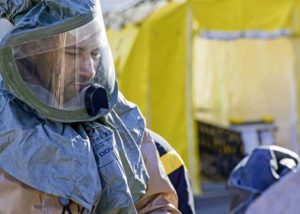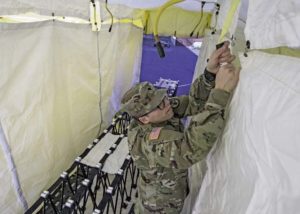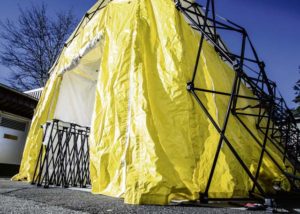
Landstuhl Regional Medical Center assessed patient decontamination capabilities during a Chemical, Biological, Radiological, Nuclear and Explosives (CBRNE) exercise at LRMC, Feb. 6.
The exercise gauged LRMC’s Patient Decontamination Team response procedures to ensure proper care of patients when exposed to contamination.
“Decontamination team members face several challenges,” said Ronald Hand, CBRNE operations officer, LRMC. “Two main scenarios are industrial contamination and weaponized contamination. The exercise (exposed) Soldiers and Airmen to a simulation of what an actual CBRNE event may look like, how our training and drills affect the results, and their own performance.”
The ability to respond to a disaster such as a hazardous material accident or attack are requirements for military trauma centers per Department of Defense and Army regulations, and a measurable process by The Joint Commission, an independent, not-for-profit organization that evaluates and accredits over 22,000 healthcare organizations in the United States.
“I am hoping the Soldiers and Airmen learn to work as a team and identify where they can enhance procedures,” said Hand, a Fayette, Ohio native.

According to the U.S. Army Medical Research Institute of Chemical Defense, patient decontamination is a labor-intensive undertaking and requires augmentation personnel, additional or specialized equipment, and training for all personnel involved. Over 20 LRMC personnel augment the PDT when needed and react at a moment’s notice to CBRNE events. Personnel are a mixture of Soldiers and Airmen who are certified in hazardous materials point of care, trained in CBRNE-unique personal protective equipment and knowledgeable on shelter systems used for these events.
In less than an hour into the exercise, team members set up a decontamination shelter system and donned HAZMAT suits, ready to receive patients. Although the exercise stopped short of simulated contaminated patients, the aim was to help ensure that the care of contaminated casualties, although more complicated than that of conventional casualties, did not stop the ongoing medical mission.

While there are three levels of patient decontamination — immediate, patient operational and patient thorough — the functions of the PDT at LRMC focus on patient thorough decontamination procedures which aims to reduce patient contamination, protecting the medical facility staff and equipment, and decontaminating any compromised skin before the patient enters the medical facility.
Because smaller forward-deployed medical units may not be staffed or equipped to perform patient thorough decontamination, LRMC would receive such patients as the only American military medical center overseas and the Role 4 theater hospital for four different combatant commands.


